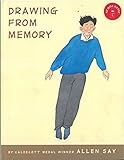The Solution to Reading Comprehension
Lessons & Units :: Drawing from Memory 5th Grade Unit
Paired Text Questions: "I Break Stuff for a Living" & Drawing from Memory
Lesson Plan
Drawing from Memory | HL560L

- Learning Goal
- Integrate information from the fiction passage “I Break Stuff for a Living” and the book Drawing from Memory to discuss the relationship between a person’s passions and profession.
- Necessary Materials
- Provided:
- Questions
- Fiction reading passage “I Break Stuff for a Living”
Not Provided:
Drawing from Memory
- Questions 1 and 2 refer to the fiction passage "I Break Stuff for a Living." Questions 3 and 4 refer to the non-fiction book Drawing from Memory. Questions 5 and 6 refer to both the passage and the book.
- Student versions of the questions are in the 'Texts & Materials' tab.
Part 1: "I Break Stuff for a Living"
Read the passage “I Break Stuff for a Living” out loud to your students. Alternatively, students can read the passage independently or as a group.
Question 1: What does the narrator love doing to bridges and computer programs?
Sample student answer: The narrator loves breaking bridges and computer programs.
Question 2: Does the narrator enjoy his job? Explain why or why not, using evidence from the passage.
Sample student answer (answers may vary but should resemble the following): Yes, the narrator enjoys his job. It allows him to break stuff, which is something he likes doing.
Part 2: Drawing from Memory
Question 3: What did Kiyoi want to become when he grew up?
Sample student answer: Kiyoi wanted to become a cartoonist.
Question 4: Why did Kiyoi want to become a cartoonist?
Sample student answer: Kiyoi wanted to become a cartoonist because he loved comic books.
Part 3: "I Break Stuff for a Living" and Drawing from Memory
Question 5: What is similar about the way the narrator in “I Break Stuff for a Living” feels about breaking things and the way Kiyoi feels about comic books?
Sample student answer: The narrator loves breaking things, just as Kiyoi loves comic books.
Question 6: What is similar about the quality assurance work done by the narrator of “I Break Stuff for a Living” and the cartooning work done by Kiyoi?
Sample student answer: Answers may vary, as long as they have a basis in the texts. Ultimately, students should recognize that the work done by both the narrator of “I Break Stuff for a Living” and that done by Kiyoi is work that allows them to do what they love.
Texts & Materials
Standards Alignment
(To see all of the ReadWorks lessons aligned to your standards, click here.)



These are a perfect segue to The Absolutely True Diary of a Part-time Indian by Sherman Alexie
Thank you your lessons are such a great resource! It is greatly appreciated because we do not have to search for supplementary materials they are all included!
This is a awesome passage
I dont know what I would do without this site. We have no textbooks for Language Arts. This site is my textbook.
I really love this site
Drawing from Memory is a book I started using in September with an student and in doing so laid a pathway for her that has resulted in a very successful academic year. Because the book is a hybrid, part graphic novel, part memoir, and part narrative history, the student experienced a literary weave using skills that are needed throughout the school year in reading and writing. The student that engaged with this book loved graphic novels so this book took her further into a more sophisticated approach to the literary form that she loved. WE adored the graphics, and we incorporated a small study of Vincent Van Gogh into our journey through the art books and visual art present in the classroom.
I found when reading your lesson plan that I had done the inquiries in the same manner that you had presented....I especially like section pages 11- 18 as a framework for student responses. Since I teach Close Reading, using Chris Lehman and Kate Roberts: Falling in Love with Close Reading, it was a perfect book to use the skill of reading with different lenses. I cannot say enough about using this book, it lends itself to work with whole class, small group, and as I did, with an individual student to transition into a more complex literature reading with sophistication and detail that requires attention to all aspects of the narrative. I highly recommend this hybrid book as a 'literary awakening' for your students. Extended lessons could include a readerly-writerly approach for students to create their own hybrid versions from a part of their personal history...